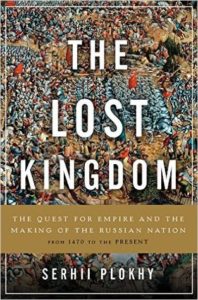Having recently written a national history of Ukraine, Plokhy turns his attention to the history of the junior eastern Slavic nation, Russia. A fair portion of Lost Kingdom describes how and why my opening sentence would outrage Russian ideologues, rulers and historians. The titles of the book’s sections reveal important aspects of his argument: Inventing Russia, The Reunification of [Kyivan] Rus’, The Tripartite Nation, and so on.
“The Russian elites’ claim for the Kyivan inheritance developed from a largely dynastic and religious concept into an ethnonational one with the start of the modern era.” (p. ix) Then that ethnonational understanding morphed into a semi-open imperial one that accepted “today’s Russians, Ukrainians and Belarusians along with imperial elites of non-Slavic origins that were Russified in political and cultural terms.” (p. ix) Then the Revolution came and tried to subsume the nations into a class structure, while simultaneously setting up polities that signified the nations’ importance. Contrarily, and also simultaneously, the USSR centralized power in Moscow to a far greater extent than the tsars had done and pursued Russification more stringently (and successfully) than the empire had managed.
The dissolution of the Soviet Union in 1991 raised the questions of Russian nationhood and statehood anew, acutely. Coming up on 30 years later, the questions are still open. “Do Russia’s present-day political borders coincide with the borders of the Russian nation? The answer depends on the way in which Russian political and intellectual leaders and Russians in general imagine their nation. The question of Russian identity and its geographic extent is of more than academic interest, as it influences issues of war and peace along Europe’s eastern frontiers today and will influence them for generations to come.” (p. x) Russia’s is not the first empire to crumble, nor will it be the last, and other nations have faced questions of their imperial legacies and post-imperial roles, including what to do with people once considered part of the center who no longer want to be part (if indeed they ever did). “[B]ut what makes the Russian situation unique is that none of those empires shared common historical roots and myths of origin with their foreign subjects, as had been the case with Russia throughout a good part of its imperial history.” (p. xi)
The only comparable situation in contemporary Europe would be if England is compelled to give up rule over Scotland. Even there, the English debt to the Scots is nothing like the Russian relationship with its Kyivan inheritance. The English did not justify centuries of conquest as the regathering of the Scots lands, as Russian rulers did with Rus’.
Plokhy moves quickly; he makes his arguments about 800 years (through 1982) of Russian and Eastern European history in just under 300 pages. He concentrates on politics, ideas, and political ideas such as the notion of Moscow as the third Rome (“and there will not be a fourth”) as a means of legitimating the Russian state and delineating it from nearby competitors in Eastern Europe such as the Ottoman Empire and the Polish-Lithuanian Commonwealth. The latter, Muscovy’s primary rival in the west, was particularly dangerous as both a potential Slavic pole (sorry) of identity and as the purveyor of an entirely different style of politics in the early modern era. The Commonwealth was headed by an elected monarch — indeed, the Polish electorate was a larger share of the population than the British electorate for Parliament — and every King was bound both by general legal precedent and by specific agreements made at each coronation. It’s about as distant as a monarchy can be from the ideology of autocracy that was developing at the same time in Muscovy and, later, Russia. That Poles had occupied Moscow at various times and even at one point placed a tsar on the throne did nothing to lessen the enmity. (Which was returned. A probably apocryphal story has a post-Communist Polish defense minister being asked what his country would do if it once again faced a two-front war against its larger neighbors. “First the Germans, then the Russians,” came the reply. Why? “Business before pleasure.”)
But it’s Ukraine and the Ukrainians that ultimately prove the immovable objects in Russian imperial history. Kyivan Rus’ is the touchstone that Muscovy drew on for legitimacy, with added links to Byzantium and the Roman Empire coming from Kyiv, just as the church came from Constantinople via Kyiv. Russian rulers appropriated the Kyivan past to their story, just as they worked to keep Ukraine part of the territory that they ruled and to make sure that the forms of that rule flowed from Moscow outward, rather than from the borderlands to the center. Belarusian (or Ruthenian, in some usages) nationhood trailed far behind, a distant third in various notions of tripartite imperial nationhood that tried to accommodate some desires of the subordinate peoples while keeping Russians firmly on top.
Plokhy spends a fair amount of time on the language politics of the 19th century, and it’s interesting, but I also thought it pulled him away from his main arguments.
He closes with the two chapters that prompted him to write the book: one (“The Russian World,” a term, Russkiy Mir, that in 2007 became the name of a foundation to promote the Russian language and Russia around the globe) on Russia’s self-conception as a nation after the Soviet collapse, and one (“The Russian War”) that specifically describes how Russia’s seizure of the Crimea and aggression against Ukraine did and did not fit with previous approaches to Russian nationhood. Naturally, Plokhy devotes considerable attention to the views of Vladimir Putin, autocrat of some of the Russias. “Will the Russian government and the Russian political and cultural elites accept the ‘loss’ of Ukraine? This is the essence of the ‘Russian question’ in its present form. As recent events have shown, the unresolved Russian question threatens peace and stability in Europe and the world in general.” (p. 351)

